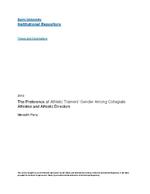|
|

Notes
- Abstract:
- Women have been underrepresented in the sports world since the beginning of time. Comfort issues regarding sex of athletes and their medical staff has been a concern since Title IX because both the number of female athletes and female athletic trainers started to increase during this time period. The significance of this study arises from the concerns of female athletic trainers regarding their status in the athletic training profession. The purpose of this study was to determine if a difference in gender acceptance of athletic trainers exists between collegiate athletes and athletic directors. An anonymous survey was distributed to athletes and athletic directors from 20 Division II institutions in the southeast United States. The surveys addressed the comfort levels of student athletes and the confidence levels athletic directors have with both male and female athletic trainers. Comfort levels and confidence levels were rated using a Likert Scale of 1 – 5; 5 representing very comfortable or very confident. A Repeated Measures ANOVA was used to determine any interaction between genders of the student athletes and compare the results for male and female athletes regarding an athletic trainer of the same and opposite sex. The final results consisted of responses from 87 student athletes, 45 female and 42 male, and 14 athletic directors, 12 male and 2 females. The results indicated that student athletes feel very comfortable (Likert Scale average score of 4.5) receiving treatment from an athletic trainer of either the same or the opposite sex. Discussing injuries involving the genitalia was the only condition where the athletes expressed discomfort. All athletes report feeling significantly less comfortable (p < .001) when discussing injuries of private nature to an athlete trainer opposite sex. Athletic directors demonstrate various confident levels with athletic trainers of both sexes. Confidence level was determined by an individual athletic trainer’s education and experience rather than his or her gender. The overall results show no specific gender preference for either a male or female athletic trainer; although, athletic directors believe that athletes feel more comfortable with an athletic trainer of the same sex and this is taken into consideration when selecting athletic trainers for their institutions.
- Thesis:
- Thesis (M.S.)--Barry University.
- Bibliography:
- Includes bibliographical references (leaves 49-53).
Record Information
- Source Institution:
- Barry University
- Holding Location:
- Barry University Archives and Special Collections
- Rights Management:
- Copyright Meredith Parry. Permission granted to Barry University to digitize, archive and distribute this item for non-profit research and educational purposes. Any reuse of this item in excess of fair use or other copyright exemptions requires permission of the copyright holder.
- Resource Identifier:
- RC1210.P37 2010_ParryMeredith ( BU-Local )
- Classification:
- RC1210.P37 2010 ( lcc )
|
|